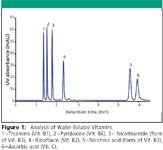Multi-Mode Water Soluble Vitamin Separation Using ZirChrom®-SAX
The Application Notebook
Traditionally the analysis of water-soluble vitamins by reversed-phase HPLC has been complicated by the lack of retention for these compounds on conventional silica C18 columns. Here we demonstrate efficient, multi-mode, baseline resolution of six water-soluble vitamins in 6 min using a ZirChrom®-SAX column.
Dr. Bingwen Yan and Dr. Clayton McNeff, ZirChrom Separations, Inc.
Traditionally the analysis of water-soluble vitamins by reversed-phase HPLC has been complicated by the lack of retention for these compounds on conventional silica C18 columns. Here we demonstrate efficient, multi-mode, baseline resolution of six water-soluble vitamins in 6 min using a ZirChrom® -SAX column.
In this application note we focus on the HPLC analysis of Vitamin C and five B-complex vitamins; Vitamin B1 (thiamine), Vitamin B2 (riboflavin), Vitamin B3 (nicotinic acid form), Vitamin B3 (nicotinamide form), and Vitamin B6 (pyridoxine). All of these vitamins are water-soluble.
Chromatographers oftentimes struggle in their attempts to analyze water-soluble vitamins by HPLC. Many water-soluble vitamins are very polar. Thiamin (Vitamin B1), pyridoxine (Vitamin B6), and ascorbic acid (Vitamin C), for example, show almost no retention on conventional C18 columns. Reversed-phase analytical methods employing ion pair reagents have been offered as a potential solution to this problem, but these methods tend to suffer from column-to-column reproducibility problems due to the somewhat unpredictable way ion-pairing reagents interact with the silica surface and the bonded phase.
In this technical bulletin we present a unique method for the analysis of water-soluble vitamins using a ZirChrom® -SAX HPLC column. ZirChrom® -SAX, an anion exchange material, is polyethleneimine-coated zirconia containing a substantial amount of hydrophobic cross-linker which imparts both ion-exchange and reversed-phase characteristics. The multi-mode retention characteristics of the ZirChrom® -SAX column create the unique selectivity ideal for this application (Figure 1).

Figure 1
For the analysis of water-soluble vitamins in serum, or other samples containing biological matrices, we recommend the addition of the ProTain® In-Line Protein Removal System; consisting of one guard holder (part# 850-00-2) and a set of three ProTain® inserts (part# PT01-0246). Please see technical bulletins #275 and #291, available at www.zirchrom.com, for further information on the use of ZirChrom's ProTain® In-Line Protein Removal System.
Experimental
Six water-soluble vitamin standards were prepared in an aqueous solution and injected on a ZirChrom® -SAX column. The separation conditions are as follows:
Column: ZirChrom® -SAX, 150 × 4.6 mm i.d., 3μm
(part number: ZR06-1546)
Mobile Phase: 50 mM Ammonium dihydrogenphosphate,
pH 4.5
Flow rate: 1.0 ml/min.
Temperature: 30°C
Injection Vol.: 5.0 μl
Detection: UV at 254 nm
The separation is shown in Figure 1. Under these conditions the separation of Vitamin C and the four B-complex vitamins is achieved, with good peak shape and baseline resolution, in 6 min.
This method can be tailored to your specific application needs. ZirChrom technical support can help to optimize and transfer this method to your site. Please contact ZirChrom technical support at 1-866-STABLE-1 or support@zirchrom.com for details.
ZirChrom phases offer unique selectivity, high efficiency, and excellent chemical and thermal stability.

ZirChrom Separations, Inc.
617 Pierce Street, Anoka, MN 55303
tel. 1-866-STABLE-1
Email: support@zirchrom.com

The Benefits of Custom Bonded Silica
April 1st 2025Not all chromatography resins are created equal. Off-the-shelf chromatography resins might not always meet the rigorous purification requirements of biopharmaceutical manufacturing. Custom bonded silica from Grace can address a wide range of separation challenges, leading to real performance improvements. Discover more about the latest innovations in chromatography silica from Grace, including VYDAC® and DAVISIL®.
5 Things to Consider When Selecting a Chromatography Silica
April 1st 2025Particularly in the pharmaceutical industry, drug purity isn’t just a goal – it’s essential for achieving safety, stability and efficacy. However, purification is easier said than done, especially with challenging molecules like DNA and RNA “oligonucleotides,” due in large part to their diversity and the range of impurities that can be generated during production. Enter DAVISIL® chromatographic silica, with a wide range of pore diameters and particle sizes to meet your specific application, performance and sustainability requirements. Before you choose the chromatography resin for your next purification application, take a look at these 5 considerations.
Automating Protein Purification: Efficiency, Yield, and Reproducibility
March 27th 2025Recent advancements in automated protein purification stress the importance of efficiency, scalability, and yield consistency. This eBook compares different purification platforms, highlighting their impact on downstream applications and demonstrating how automation enhances throughput and process control.
MilliporeSigma: Ultrapure Water for Sensitive LC-MS Analysis of Pesticides
March 25th 2025The aim of the study was to illustrate the efficiency of Milli-Q® water purification systems in eliminating pesticides from tap water, thereby producing and delivering reliable and consistent-quality ultrapure water suitable for pesticides analysis















